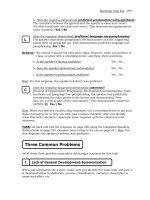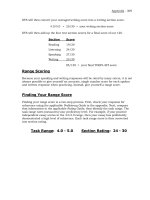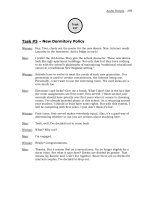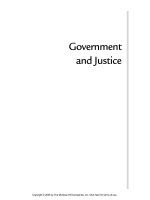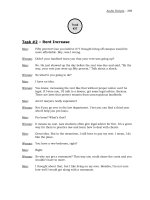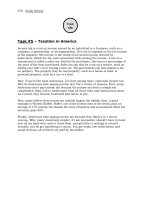perfect phrases for the toefl - writing and speaking sections (2008)
Bạn đang xem bản rút gọn của tài liệu. Xem và tải ngay bản đầy đủ của tài liệu tại đây (4.9 MB, 178 trang )
Perfect Phrases forthe TOEFL
Speaking and Writing Sections
This page intentionally left blank
Perfect Phrases forthe TOEFL
Speaking and Writing Sections
Hundreds of Ready-to-Use Phrases to
Improve Your Conversational Ability,
Develop Your Writing Skills,and
Build Exam Confidence
Roberta G. Steinberg
New York Chicago San Francisco Lisbon London
Madrid Mexico City Milan New Delhi San Juan
Seoul Singapore Sydney Toronto
Copyright © 2008 by The McGraw-Hill Companies, Inc. All rights reserved.Manufactured
in the United States of America. Except as permitted under the United States Copyright
Act of 1976, no part of this publication may be reproduced or distributed in any form or
by any means, or stored in a database or retrieval system, without the prior written permis-
sion of the publisher.
0-07-159247-4
The material in this eBook also appears in the print version of this title: 0-07-159246-6.
All trademarks are trademarks of their respective owners. Rather than put a trademark
symbol after every occurrence of a trademarked name, we use names in an editorial
fashion only, and to the benefit of the trademark owner, with no intention of infringement
of the trademark. Where such designations appear in this book, they have been printed with
initial caps.
McGraw-Hill eBooks are available at special quantity discounts to use as premiums and
sales promotions, or for use in corporate training programs. For more information, please
contact George Hoare, Special Sales, at or (212)
904-4069.
TERMS OF USE
This is a copyrighted work and The McGraw-Hill Companies, Inc. (“McGraw-Hill”) and
its licensors reserve all rights in and to the work. Use of this work is subject to these terms.
Except as permitted under the Copyright Act of 1976 and the right to store and retrieve one
copy of the work, you may not decompile, disassemble, reverse engineer, reproduce, mod-
ify, create derivative works based upon, transmit, distribute, disseminate, sell, publish or
sublicense the work or any part of it without McGraw-Hill’s prior consent. You may use the
work for your own noncommercial and personal use; any other use of the work is strictly
prohibited. Your right to use the work may be terminated if you fail to comply with these
terms.
THE WORK IS PROVIDED “AS IS.” McGRAW-HILL AND ITS LICENSORS MAKE
NO GUARANTEES OR WARRANTIES AS TO THE ACCURACY, ADEQUACY OR
COMPLETENESS OF OR RESULTS TO BE OBTAINED FROM USING THE WORK,
INCLUDING ANY INFORMATION THAT CAN BE ACCESSED THROUGH THE
WORK VIA HYPERLINK OR OTHERWISE, AND EXPRESSLY DISCLAIM ANY
WARRANTY, EXPRESS OR IMPLIED, INCLUDING BUT NOT LIMITED TO
IMPLIED WARRANTIES OF MERCHANTABILITY OR FITNESS FOR A PARTICU-
LAR PURPOSE. McGraw-Hill and its licensors do not warrant or guarantee that the
functions contained in the work will meet your requirements or that its operation will be
uninterrupted or error free. Neither McGraw-Hill nor its licensors shall be liable to you or
anyone else for any inaccuracy, error or omission, regardless of cause, in the work or for
any damages resulting therefrom. McGraw-Hill has no responsibility for the content of any
information accessed through the work. Under no circumstances shall McGraw-Hill and/or
its licensors be liable for any indirect, incidental, special, punitive, consequential or simi-
lar damages that result from the use of or inability to use the work, even if any of them has
been advised of the possibility of such damages. This limitation of liability shall apply to
any claim or cause whatsoever whether such claim or cause arises in contract, tort or
otherwise.
DOI: 10.1036/0071592466
We hope you enjoy this
McGraw-Hill eBook! If
you’d like more information about this book,
its author, or related books and websites,
please click here.
Professional
Want to learn more?
Contents
Part I. Introduction: How to Use the Book 1
Part II. The Speaking Section 3
Chapter 1. Description of Tasks 5
A. Independent Task: Speaking, Personal Preference 6
B. Independent Task: Paired Choice Task 10
C. Integrated Task: Reading/Listening/Speaking
(Campus-based)14
D. Integrated Task: Listening/Reading/Speaking
(Academic topic)22
E. Integrated Task: Listening/Speaking (Campus-based)29
F. Integrated Task: Listening/Speaking (Academic topic)35
Chapter 2. Phrases and Vocabulary for the
Speaking Section with Reference
to Skill and Purpose 41
v
For more information about this title, click here
Chapter 3. Speaking Skill Development 51
A. Websites for Improving Listening Skills 51
Part III. The Writing Section 53
Chapter 4. Description of Tasks 55
A. Independent Task 55
B. Integrated Task 61
Chapter 5. Phrases and Vocabulary for the
Writing Section with Reference
to Skill and Purpose 73
Chapter 6. Writing Skill Development 83
A. Suggestions for the Independent Task 83
B. Suggestions for the Integrated Task 85
Part IV. Vocabulary Development 87
Chapter 7. Summarizing Practice 89
A. Increasing Vocabulary through Reading 89
B. Increasing Vocabulary with the Academic Word Lists 89
vi
Contents
Appendix I Grammar 97
A. Grammar Pretest 97
B. Grammar Rules and Exercises 101
C. Grammar Posttest 147
Appendix II Punctuation 155
A. Punctuation Pretest 155
B. Punctuation Rules 157
C. Punctuation Posttest 162
vii
Contents
This page intentionally left blank
Perfect Phrases for the TOEFL
Speaking and Writing Sections
This page intentionally left blank
Part I
Introduction: How to
Use the Book
The TOEFL iBT (Internet-based Test) is different from previous
TOEFL exams in that it includes a speaking section and an inte-
grated writing section. Students who have taken the test have
found these additional sections to be particularly difficult.
Using this book will help you prepare for these two sections.
You will become familiar with the types of tasks or prompts for
each section. Each prompt in this book is followed by a
response, which highlights the vocabulary and phrases you can
use when you take the test. By studying the phrases and vocab-
ulary organized by skill and purpose,you will gain confidence in
your speaking and writing ability.
The book is divided into three sections: the speaking sec-
tion, the writing section, and suggestions for vocabulary devel-
opment. In the speaking and writing sections, you will learn
what is tested on the IBT exam. The speaking section tests six
different types of tasks. The writing section tests two different
types of tasks. For each task, you will find:
■ A description of the particular task you must perform.
■ Two sample questions/lectures/conversations.
Copyright © 2008 by The McGraw-Hill Companies, Inc. Click here for terms of use.
■ Sample responses with note-taking suggestions and
preparation tips.
■ Phrases and vocabulary with reference to each type of
task, organized by skill and purpose.
At the end of the listening section you will find a list of
helpful Websites. As you prepare for the test by listening to
native English speakers as well as by reading and writing every
day, you will recognize the need to improve your vocabulary.
The suggestions for vocabulary development section includes
several time-tested strategies as well as the Academic Word
List, a 300-word list of the most frequently used words in
university lectures as compiled by Averil Coxhead.
At the end of the book are two appendixes, one a grammar
section with rules and exercises and the other a punctuation
section with rules. Several of the exercises include actual
student errors. Each appendix has a pretest and posttest with
answer keys that direct you to the particular rule being tested.
These sections will help you prepare for the TOEFL writing
and speaking sections. They will be of particular help with
your writing.
Good luck on the exam and feel free to e-mail me with any
questions or comments at
2
Perfect Phrases for the TOEFL Speaking and Writing Sections
Part II
The Speaking Section
Copyright © 2008 by The McGraw-Hill Companies, Inc. Click here for terms of use.
This page intentionally left blank
Chapter 1 Description of Tasks
I
n the speaking section you will answer six questions while
you are speaking into a microphone. The first two tasks are
the easiest. They are about topics that are familiar to you.
These topics are called independent tasks. One will be a per-
sonal preference, and one will be a paired choice, a question
that asks you to make and defend a choice between two dif-
ferent behaviors. The third and fourth tasks, integrated tasks,
involve listening, reading, and speaking. One of these tasks is
about a campus-based situation, and the other involves an
academic topic. The fifth and sixth integrated tasks integrate
listening and speaking skills.Again, one is campus-based, while
the other is academic.
You will take notes to help you prepare for your responses.
You will be given a short amount of time, between 15 and
30 seconds, to prepare your responses.You will speak for either
45 or 60 seconds. A clock on the computer shows the time.
5
Copyright © 2008 by The McGraw-Hill Companies, Inc. Click here for terms of use.
A. Independent Task: Speaking,
Personal Preference
You will hear a single question that asks you to express and
defend a choice from a given category, for example, people,
places, events, or activities. Your answer will express your opin-
ion, and you will be expected to provide the reasons that
support your opinion.
1. Sample Prompt with Response
■ Here is the kind of question you will be asked:
6
Perfect Phrases for the TOEFL Speaking and Writing Sections
If you could visit any foreign country in the world for
two weeks, all expenses paid, which country would it
be and why?
15 seconds preparation time; 45 seconds to speak
■ In the 15 seconds of preparation time, you could write
down the bulleted items shown below to help you get
ready to respond.
Preparation Notes
Although a country may not come to mind right away, just pick
one. Don’t waste valuable time trying to find a “best” choice. Any
country will work as long as you have specific reasons for wanting
to go there.Once you choose,start listing in bullet form the partic-
ulars. The more specific and detailed your answer is, the better it
will be.
■ Where? India
■ Why?
■ Differences: smells, food, appearance, customs, religion,
way of life
■ How it might change my life
This speaking task is the easiest one.Watch the clock to make sure
you don’t go over the time limit.
■ Here is a sample response. Underlined words and
phrases are categorized in Chapter 2, Phrases and
Vocabulary for the Speaking Section with Reference
to Skill and Purpose.
7
Description of Tasks
Let’s see (S1).That’s an interesting question (S1).If I could
(S3) travel to one country for free, I believe (S2) I’d go to
India. I’
d like to explain why (S2).First of all (S4), India is
very different from where I have always lived. P
ersonally
(S2),I’d enjoy (S2) visiting a country with such exotic cus-
toms, appearances, smells, and food. In addition
(S4),I’d
have the chance to observe people whose religion, beliefs
➥
2. Sample Prompt with Response
■ Here is the kind of question you will be asked:
8
Perfect Phrases for the TOEFL Speaking and Writing Sections
and practices are ones I know very little about. Even if (S3)
the visit were a short one, I’m sure it would be eye-
opening. T
o summarize (S5), if I could (S3) go to India, I’d
be able to (S6) experience a nation that is unlike any I’ve
ever known. A
bove all (S11), I’m sure that as a result (S7)
I’
d be capable of (S6) thinking about things differently.
If you could have any job, what would it be and why?
15 seconds preparation time; 45 seconds to speak
■ In the 15 seconds of preparation time, you could write
down the bulleted items shown below to help you get
ready to respond.
Preparation Notes
You may not have any idea of what you might consider an ideal
job, but just quickly pick a job. Any job, as long as you have specific
reasons for why you would like it, will work.Once you choose, start
listing in bullet form the particulars.The more specific and detailed
your answer is, the better it will be.
■ The job. A doctor
■ Why?
■ Help people
■ Respected profession
■ Make a good living
■ Never routine
Watch the clock to make sure you don’t go over the time limit.
■ Here is a sample response. Underlined words and
phrases are categorized in Chapter 2, Phrases and
Vocabulary for the Speaking Section with Reference
to Skill and Purpose.
9
Description of Tasks
Let me think (S1).That’s a good question (S1).If I could (S3)
have any job, I think
(S2) I’d enjoy (S2) being a doctor.As far
as I’m concerned (S2), a doctor certainly (S11) is not only
(S13) respected but also (S13) able (S6) to positively affect
the lives of many people. E
very day (S8) a doctor sees
different patients and must make life-altering decisions. On
the whole (S6), the job is never (S8) routine or boring, for
(S17) no two patients are alike. Furthermore (S4),a doctor
must keep learning new things. In spit
e of (S10) the
demands, a doctor remains challenged as w
ell as (S16)
motivated. W
hat’s more (S4), a physician makes a lot of
money, c
ompensation for (S17) the many years of study
and grueling hours. U
nquestionably (S10),I’d be (S2) a
doctor if I c
ould (S3) choose any job.
B. Independent Task: Paired Choice Task
You will hear a single question that asks you to make and
defend a choice between two different behaviors. Your answer
will express your opinion, and you will be expected to provide
the reasons behind your opinions. The question is personal
in nature.
1. Sample Prompt with Response
■ Here is the kind of question you will be asked:
10
Perfect Phrases for the TOEFL Speaking and Writing Sections
Some high schools require all students to wear a
uniform to school. Other schools allow students to
wear whatever they want.Which policy do you think is
better and why?
15 seconds preparation time; 45 seconds to speak
■ In the 15 seconds of preparation time, you could write
down the bulleted items shown below to help you get
ready to respond.
Preparation Notes
Although you may not have an opinion about which policy is bet-
ter, you’ll need to quickly make up your mind. Brainstorm your
ideas in two columns, and again list bulleted specifics.
With Uniforms Without Uniforms
■ Cheaper, don’t need many outfits ■ Fosters individuality
■ Promotes equality ■ Fosters originality
■ Promotes school identification/
belonging
Maybe you don’t have an opinion. Since you have more reasons
for wearing a uniform,choose that side.What’s important is to act
quickly. Just as in an essay,you’ll have an introduction,supporting
evidence, and a conclusion. Watch the clock; 45 seconds goes by
quickly.
■ Here is a sample response. Underlined words and phrases
are categorized in Chapter 2, Phrases and Vocabulary for
the Speaking Section with Reference to Skill and Purpose.
11
Description of Tasks
Whether to (S3) allow high school students to choose what
they wear to school is an in
teresting question (S1) because
(S7) everyone has been to high school and has thought
about this issue. T
here are three reasons (S4) why I believe
(S2) students should wear uniforms. First (S4), you don’t
have to worry about what to wear each day. S
econd (S4),
when everyone is wearing the same thing, no one appears
richer or poorer than anyone else based on clothing. F
inally
(S5), and most importantly (S5), wearing a uniform pro-
motes camaraderie and identification with a school. In c
on-
clusion (S5), although (S10) some may argue that (S10) not
wearing a uniform promotes freedom of expression and
individuality, o
verall (S9), the ease and sense of belonging
by wearing a uniform mak
es it a better policy (S15).
2. Sample Prompt with Response
■ Here is the kind of question you will be asked:
12
Perfect Phrases for the TOEFL Speaking and Writing Sections
Some students prefer to take online courses. Others
prefer to study in a classroom with a live teacher.
Which do you think is better and why?
15 seconds preparation time; 45 seconds to speak
■ In the 15 seconds of preparation time, you could write
down the bulleted points shown below to help you get
ready to respond.
Preparation Notes
Although you may not have an opinion about which option is
better,you’ll need to quickly make up your mind.Brainstorm your
ideas in two columns, and again list bulleted specifics.
O
nline In a Classroom
■ Can do the course in pajamas ■ Can ask the teacher ques.
whenever
■ Can go at my speed/ ■ Can learn from other
repeat lectures students/can meet
■ Don’t spend time commuting with them after class
Maybe you don’t have a strong opinion, but since you have
more reasons for taking online courses, choose that side. What’s
important is to act quickly. Just as in an essay,you’ll have an intro-
duction, supporting evidence, and a conclusion. Watch the clock;
45 seconds goes by quickly.
■ Here is a sample response. Underlined words and phrases
are categorized in Chapter 2, Phrases and Vocabulary for
the Speaking Section with Reference to Skill and Purpose.
13
Description of Tasks
There are two ways to take college courses. One option is
(S20) to take the course online. The other option is (S1)
to take the course in a traditional college classroom.
A
lthough (S10) there are benefits (S13) to both, it seems
to me (S2) that taking a course online might be the better
option (S15).First (S4), I can decide when (S8) to go
online,which may be while
(S8) I’m lying in bed or even in
my pajamas. S
econd (S4),if(S3) I need to replay the lec-
ture, I’
m able to (S6) as many times as (S16) needed.
F
inally (S5), I don’t have to get dressed and commute to a
classroom, which might take a very long time. E
ven
though (S10) others may argue (S14) that taking a course
in a classroom enables
(S6) interaction with teachers and
students, on the whole
(S5)for me, taking a class online is
the better option (S15).
